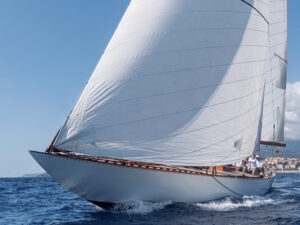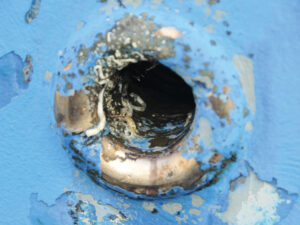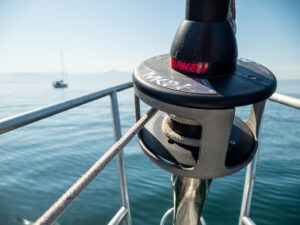Antifouling paint is nasty stuff. That’s why nothing (supposedly) grows on it. Accordingly, when sanding or applying it, wear a respirator (a dust mask is OK for sanding but definitely not for application), gloves, and eye protection. Be especially careful not to get it in mucous membranes¿eyes, nose, and mouth.
It’s an old painting axiom, but there’s something to it: “Preparation is everything,” and it holds true for antifouling paint as well. Follow the manufacturer’s instructions. In addition to compatibility and preparation issues, such as sanding and solvent wiping, most paint manufacturers stipulate a minimum air and hull temperature that’s required for proper application.
Most yards pressure wash bottoms when boats are hauled. This is a good start for paint prep. If, however, the yard where you haul uses a waste-water recycling system, essentially filtering and reusing the wash water, ensure that it’s operating properly. Vessels washed with contaminated water and then painted often suffer from “unexplained” paint-release problems.
Lay it on. Most bottom paints, especially ablative paints, are designed to be applied in heavy coats. Remember, the life of such paint is directly affected by how much of it is applied. If your roller passes are leaving dry spots that you have to go over again, you are being skimpy with the paint. Yes, it’s expensive, but if you try to stretch it too much, it will yield poor results¿and whatever you do, don’t thin it.
Of course, you’ll want to mask your waterline. It helps to clean the area where the masking tape will be applied before you stick it up. This will prevent paint “fingers” seeping up into the topsides. If you intend to leave the tape in place, even just overnight, use Scotch all-weather masking tape¿Blue Long Mask (Number 2090) for up to a week, Silver Weather Resistant (Number 225) for longer (3M Marine, 877-366-2746, www.3m.com/marine).
Antifouling paint rarely adheres to running gear such as props and shafts. It’s usually spun off within the first hour of running. If you intend to keep these areas painted, use one of the proprietary underwater metal primers designed for this. They’re a bit time-consuming to apply, but most’such as Interlux’s 2000 or Primocon series primer¿will markedly increase the life of paint applied to underwater metals.
Homegrown additives such as spices and antibiotics may actually have the opposite effect from that which is intended. These additives may upset the paint’s binder balance or impair the release of biocides. Paint manufacturers and chemists spend lots of time and money creating effective antifoulants. There’s a good chance they’ve already tested Jimbo’s Red Hot Cajun Chili Pepper Sauce and found that most bottom critters don’t mind the taste.
Steve D’Antonio








